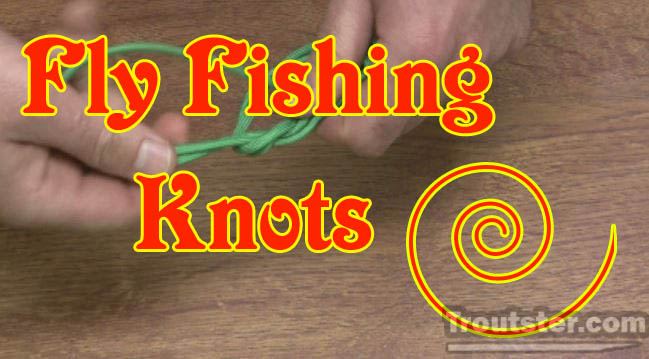This post was last updated on December 23rd, 2015 at 01:06 am
The Various Knots Every Fly Fisherman Should Know
Fly fishing knots are a key part of you becoming a successful fly fisherman. If you are a new angler, you should at least try to get a couple of these knots engraved in your memory. The key to learn these for the long term is practice, and if you aren’t fishing at-least 50 days per year—you aren’t getting enough practice in (just kidding – everyone has their own schedules). You could always grab a spool of fishing line and practice them in the winter while you are sitting around having a netflix and chill day.
Setting up a fly fishing reel? Here I go over the entire procedure (on video and print) for setting up a fly reel.
Get your tying fingers ready, because we are going to get started tying some knots! This first knot is the one I prefer to use to tie my flies onto my tippet.
Clinch Knot
This extremely simple knot is one that you will probably be familiar with. It is perhaps the most common fishing knot used to tie on flies or lures. There are two variations of this knot know as the regular clinch knot (Which is what I use) and the improved clinch knot, which requires one extra simple step. In this demonstration I am tying the standard clinch knot.
Tying the Clinch Knot
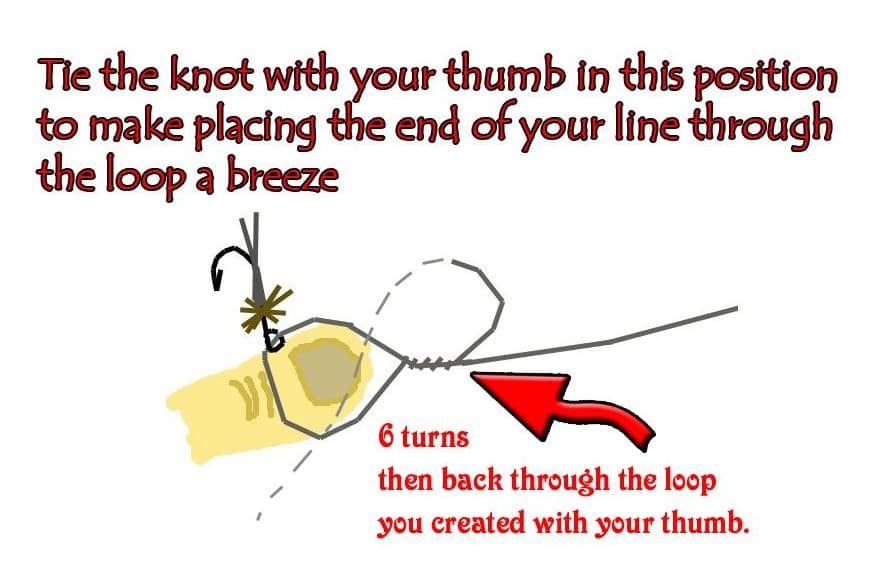
Here is a quick video demonstration on the clinch knot.
Blood Knot
The blood knot is a great way to connect two similarly sized lines together. If you wanted to tie a 5x piece of tippet onto your 4x leader, this would be a great way to do it. It is my favorite knot for tying leaders and attaching tippets etc.
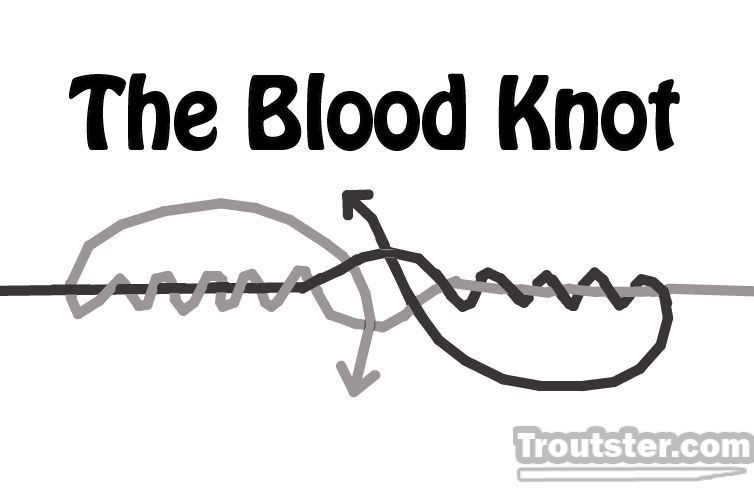
This illustration shows how to tie this knot, but I recommend watching the video below. In this video I will show you how to tie this knot using a trick that will make it very easy to tie quickly. The trick involves placing your thumb in a certain spot while tying, with a little practice you will be able to tie this knot in very low light and even at night with no light at all!
The Albright Knot
This knot is generally used to tie 2 different sized lines together; one small and one thick diameter, such as backing to flyline. It will also work well in place of the nail knot for attaching a butt section or a leader to your thick diameter fly line. If you don’t have a nail knot tool or a nail handy, this knot works very well for this use.
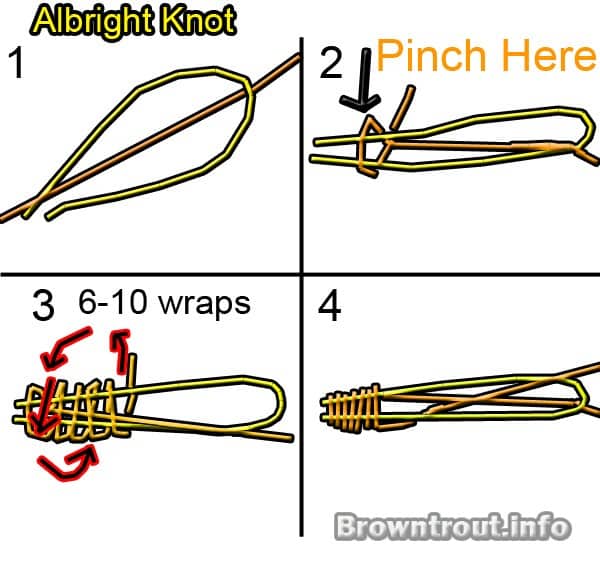
The video below would be the best way to learn to tie this very useful knot. This is a tough one to show well in diagrams.
The Perfection Loop
This knot is great for making loops in monofilament and fluorocarbon leaders for quick detach. Many fly lines and leaders come with a loop already made for you, but some don’t. Heaven forbid you get on the river and you pull out a fresh leader without a perfection loop knot already in it. Never fear, because after you watch this video you will be tying this great knot with your eyes closed! This knot is simply a couple loops and you are done, is a pretty easy knot and it seems to stick really easily in your mind once you tie it a couple times.
Double Surgeon or Surgeons Loop Knot
Of all of the various fly fishing knots, this one is like a walk in the park compared to some of the knots on this page. If you don’ want to learn the blood knot, you should at least ensure you get this simple knot down pat. While on the river, you will need to know how to connect 2 lines of similar size together. This knot is literally tying two simple granny knots and you will have it completed. Typically this knot is used to tie tippets together or for assembling your own leaders. If you are having trouble with the blood knot, or you simply need to connect line quickly because there is a huge trout feeding in front of you, this knot is fast and easy.
The Arbor Knot
This knot is very easy, and very necessary to get right. There will come a day where for whatever reason or circumstance, all of your line and backing gets pulled out of your reel, and you end up testing this knot. Learn to tie it properly, so if that day comes you won’t loose all of your line! I have not made a video for instructions on the arbor knot, because it should be easy to understand from this image below. If you are setting up a fly reel you can see how to tie this knot on this video.
Steps for tying this knot include:
- Wrap your backing around the arbor of your reel
- Tie one overhand simple granny knot around the line coming from your backing spool, but don’t cinch it too tight yet
- Tie another 1-2 overhand knots on the end of your backing tag end
- Slowly pull the long end of your backing away from your reel until the knot is well seated
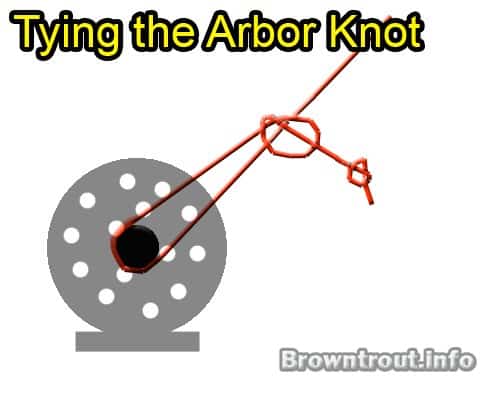
The Nail Knot
This knot can get fairly involved until you get the hang of it. The nail knot is fairly important fly fishing, but not 100% necessary to know. As mentioned above the albright knot will work in it’s place. This knot is used to tie your leader or butt section to the fly line. Perhaps it’s greatest benefit is its slim profile as it slides easily through the guides of your fly rod. This is one of the most tricky fly fishing knots, but it can be made easier by using a nail knot tool. Using the diagram below you should be able to tie this knot fairly easily. I have also included a video about how to tie the nail knot using a Cortland Knot Tier Tool and how to tie it using a nail.
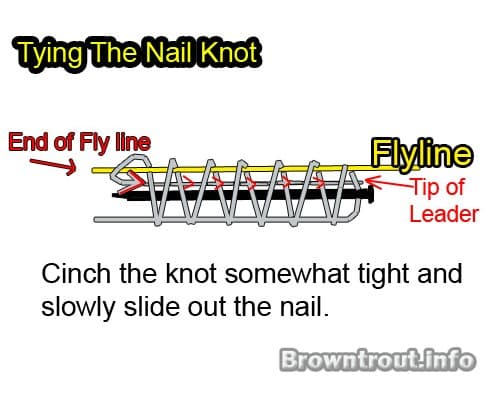
I hope you were able to learn a thing or two about these common knots. Fly fishing knots don’t have to be hard to tie, all you need is a little bit of practice and you’ll be tying them at the speed of light. If you ave any comments or questions about any of these knots, feel free to use the comment form below.

